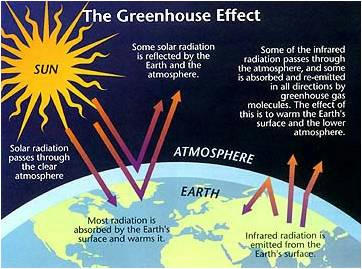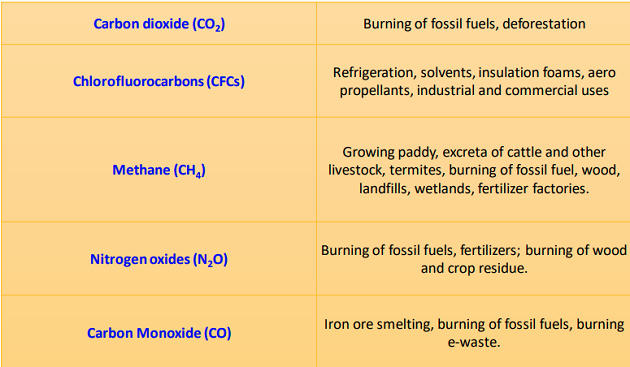Table of Contents
Greenhouse Effect
- Greenhouse effect is the process by which radiations from the sun are absorbed by the greenhouse gases and not reflected back into space. This insulates the surface of the earth and prevents it from freezing.

- A greenhouse is a house made of glass that can be used to grow plants.
- The sun’s radiations warm the plants and the air inside the greenhouse.
- The heat trapped inside can’t escape out and warms the greenhouse which is essential for the growth of the plants.

- In a greenhouse, the incident solar radiation (the visible and adjacent portions of the infrared and ultraviolet ranges of the spectrum) passes through the glass roof and walls and is absorbed by the floor, earth, and contents, which become warmer and re-emit the energy as longer-wavelength infrared radiation (heat radiation).
- Glass and other materials used for greenhouse walls do not transmit infrared radiation, so the infrared cannot escape via radiative transfer.
- As the structure is not open to the atmosphere, heat also cannot escape via convection, so the temperature inside the greenhouse rises. This is known as the ‘greenhouse effect’.
Greenhouse Gases (GHGs)
- Greenhouse gases are the gases that absorb the infrared radiations and create a greenhouse effect. For eg., carbondioxide and chlorofluorocarbons.”

- The major contributors to the greenhouses gases are factories, automobiles, deforestation, etc.
- The increased number of factories and automobiles increases the amount of these gases in the atmosphere.
- The greenhouse gases never let the radiations to escape from the earth and increase the surface temperature of the earth. This then leads to global warming.
- Carbon dioxide is meteorologically a very important gas as it is transparent to the incoming solar radiation but opaque to the outgoing terrestrial radiation.
- Ozone is another important greenhouse gas. But it is in very small proportions at the surface.
- Water vapour is also a variable gas in the atmosphere, which decreases with altitude.
- Water vapour also decreases from the equator towards the poles.
- Methane is the most important greenhouse gas after carbon dioxide.
- N2O or Nitrous Oxide is a greenhouse gas.
- NO and NO2 (nitric oxide or nitrogen oxide and nitrogen dioxide) emissions cause global cooling through the formation of (OH) radicals that destroy methane molecules, countering the effect of GHGs.
- Carbon monoxide is a short-lived greenhouse gas (it is less dense than air).
Chlorofluorocarbons (CFCs)
- CFCs were phased out via the Montreal Protocol due to their part in ozone depletion
- Black carbon (BC) is a solid particle or aerosol (though not a gas) that contributes to warming of the atmosphere. Black carbon, commonly known as soot.
- Soot is a form of particulate air pollutant, produced from incomplete combustion.
Brown Carbon
- Brown carbon is a ubiquitous and unidentified component of organic aerosol.
- Biomass burning (possibly domestic wood burning) is shown to be a major source of brown carbon
- Brown carbon is generally referred for greenhouse gases and black carbon for particles resulting from impure combustion, such as soot and dust.
GHG Protocol
- GHG Protocol is developing standards, tools and online training that helps countries, cities and companies track progress towards their climate goals.
- GHG Protocol establishes frameworks to measure and manage greenhouse gas (GHG) emissions from private and public sector operations, value chains and mitigation actions.
- Burning of Fossil Fuels
- Deforestation
- Farming
- Industrial Waste and Landfills
Effects of Greenhouse Effect
- Global Warming
- Depletion of Ozone Layer
- Smog and Air Pollution
- Acidification of Water Bodies
- Runaway Greenhouse Effect
Impact
- Melting of the ice caps
- Extreme Climatic Events
- Environmental Degradation
- Rising Health Related Issues
- Biodiversity Loss
- No Food Security
- Deterioration of Carbon sinks
- Sea Level Change
What is ‘Greenhouse Gas Protocol’? (2016)
- It is an international accounting tool for government and business leaders to understand, quantify and man-age greenhouse gas emissions
- It is an initiative of the United Nations to offer financial incentives to developing countries to reduce green-house gas emissions and to adopt eco-friendly technologies
- It is an inter-governmental agreement ratified by all the member countries of the United Nations to reduce greenhouse gas emissions to specified levels by the year 2022
- It is one of the multilateral REDD+ initiatives hosted by the World Bank
Q4. What is ‘Greenhouse Gas Protocol’? (2016)
- It is an international accounting tool for government and business leaders to understand, quantify and man-age greenhouse gas emissions
- It is an initiative of the United Nations to offer financial incentives to developing countries to reduce green-house gas emissions and to adopt eco-friendly technologies
- It is an inter-governmental agreement ratified by all the member countries of the United Nations to reduce greenhouse gas emissions to specified levels by the year 2022
- It is one of the multilateral REDD+ initiatives hosted by the World Bank
Q.)In the context of mitigating the impending global warming due to anthropogenic emissions of carbon dioxide, which of the following can be the potential sites for carbon sequestration?
- Abandoned and uneconomic coal seams
- Depleted oil and gas reservoirs
- Subterranean deep saline formations
Select the correct answer using the code given below:
- 1 and 2 only
- 3 only
- 1 and 3 only
- 1, 2 and 3
Q.)In the context of mitigating the impending global warming due to anthropogenic emissions of carbon dioxide, which of the following can be the potential sites for carbon sequestration?
- Abandoned and uneconomic coal seams
- Depleted oil and gas reservoirs
- Subterranean deep saline formations
Select the correct answer using the code given below:
- 1 and 2 only
- 3 only
- 1 and 3 only
- 1, 2 and 3
Latest Burning Issues | Free PDF





















 WhatsApp
WhatsApp